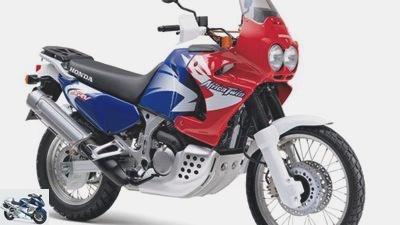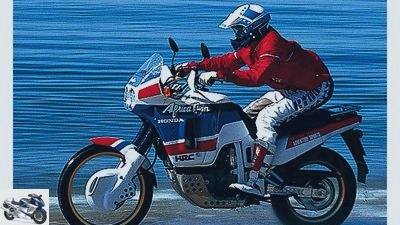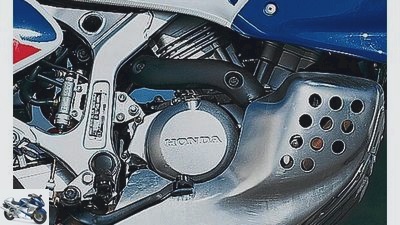Table of contents
- Used advice Honda Africa Twin (1988 – 2003) Inexpensive and stable value jack-of-all-trades
- sightseeing
- Market situation
- Technical specifications
- Model history
- Used Honda Africa Twin in Germany

archive
counselor
Used purchase
Second-hand advice: Honda Africa Twin
Used advice Honda Africa Twin (1988 – 2003)
Inexpensive and stable value jack-of-all-trades
Despite strong competition from current travel enduros, the star of yore is still doing very well: as an inexpensive, stable all-rounder.
Thorsten Dentges
07/08/2010
The paint is off. With some used Africa Twins literally, because as globetrotters pack donkeys they have seen pretty much everything during their working life: desert slopes, mountain roads, coastal routes, metropolitan routes. Aged with dignity, a few wrinkles and scars are perfectly fine. Adventurers are not clean-shaven. On other, mostly younger, less widely traveled specimens, however, the paint is also off. At least symbolically. From a technical point of view, the machine that used to set accents – at least in the travel enduro scene – is a crumbling monument. At the end of the eighties was the original twin with its 650 cm? and 57 PS and an unbeatable chassis, a blast for off-road enthusiasts. The first 750 from 1990 continued its success on the country road and established itself in the travel scene. With the RD07 from 1993, Honda completed its work and built a perfect all-rounder that says “yes” to everything without complaint: Autobahn, serpentine spirals, gravel pulling paths.
The enormous versatility, including pillion compatibility, made the two-cylinder machine a top seller with a soul. For fans, and there were and are many of them, it was therefore incomprehensible why Honda saw off the great Africa Twin 2003 without an adequate successor. Compared to current travel enduros, the only 60 hp and almost 240 kilogram Honda naturally stinks these days. It doesn’t have ABS either. However, if you can experience the twin live, you will notice that key data on paper is not everything. In the sum of all its properties, the XRV is still a brilliant motorcycle. An aging star on the second-hand market, but a thoroughly honest one with no airs whatsoever. And hiring them is absolutely affordable.
Internet:
Fansites: www.africatwin.de, www.atic.org
Tests in MOTORCYCLE:
RD03: 6/1988 (VT), 23/1988 (VT), 10/1989 (VT) .RD04: 3/1990 (T), 14/1990 (VT), 14/1992 (VT) .RD07 / a: 6/1993 (T), 13/1993 (VT), 22/1993 (KV), 16/1995 (VT), 14/1999 (VT)
T = test, VT = comparison test, KV = concept comparison;
Repeat orders by phone 0711 / 182-1229
sightseeing
There are hardly any weak points, but they do exist: on the RD07, this is the fuel pump. Connoisseurs replace them with replacement products from Pierburg (phone 02133/267167) or Mikuni (via African Queens, phone 08441/18442, www.africanqueens.de). Another small problem is the comparatively narrow, steeply sloping bench. If this has already been done, comfort falls by the wayside on long stages. Dilettantically upholstered benches bring no pluses, only professional work or proven products from the aftermarket (for example African Queens or Corbin, phone 06371/18637, www.corbin.de). Be careful with repainted and rebuilt specimens: This often indicates a past that was hit and missed (off- or on-road). However, if the history of the used machine in question is documented by the service booklet, invoices and other papers, mileage beyond 50,000 kilometers should not be an obstacle to purchase.
Market situation

archive
A collector’s item: The 650 Africa Twin from 1988 is extremely rarely available in good condition.
The trade in used Africa Twin is a private matter. There are two reasons for this: For dealers, machines that have been driven a lot (more than 50,000 kilometers) and some of them well over ten years old are too financially risky due to the warranty obligation, and at the same time, due to the good reputation of Honda, private sellers have the best chances of marketing their used machines on their own . The Africa Twin is considered to be very stable in value, even for around 15-year-old RD07s, despite mileage of over 40,000 kilometers, sometimes well over 3,000 euros are still being called. Of all Africa Twin (current total: around 11,000 units), the RD07 was the bestseller (the years 1993 to 1998 alone, around 40 percent of all registrations), the somewhat unpopular RD04s sold around 4,000 times and is well-maintained for around 2,000 euros , while the RD03 is more of a rarity with only a few hundred registrations left as a second-hand offer.
Availability on the market: high
| Price level in euros |
Years of construction | Mileage |
| Low 1800-2800 | 1988-1994 | over 40,000 | Medium 2500-4200 | 1993-2000 | 25000-60000 |
| High 4300-5300 | 1998-2003 | 15000-35000 |
| Type | in program |
Sales | RD03 | 1988-1989 | 1464 |
| RD04 / RD07 | 1990-2003 | 19900 |
Technical specifications

archive
The extremely robust V2 protected by an aluminum tub.
Engine:
Water-cooled two-cylinder four-stroke engine, 52-degree V-engine, three valves per cylinder, wet sump lubrication, carburetor, no exhaust gas cleaning, mechanically operated multi-disc oil bath clutch, five-speed gearbox, O-ring chain.
Bore x stroke 81 x 72 mm
Displacement 742 cc
rated capacity 44 kW (60PS) at 7500 rpm
Max. Torque 62 Nm at 6000 rpm
Landing gear:
Double loop frame made of steel, telescopic fork, two-arm swing arm made of aluminum, central spring strut with lever system, adjustable spring base, double disc brake at the front, disc brake at the rear.
Wire spoke wheels 1.85 x 21; 2.75 x 17
Tires 90 / 90-21 H, 140/80 HR 17.
Mass and weight:
Wheelbase 1565 mm, steering head angle 62.5 degrees, caster 112 mm, seat height * 860 mm, weight with a full tank * 236kg, payload * 189 kg, tank capacity / reserve 23 / 5.1 liters.
Measurements (MOTORRAD 14/1999):
Top speed 180 km / h
Acceleration 0-100 km / h 4.6 sec
Pulling 60-100 km / h 5.4 sec
Consumption 4.9 l / 100 km (country road); 7.6 l / 100 km (at 160 km / h), normal
* MOTORCYCLE measurements
Model history
1988 Two years after the Dakar rally victory of the factory NXR 750 machine, Honda is launching the XRV 650 Africa Twin, type RD03, a street-legal offshoot for 10570 marks (5404 euros). The 57 hp two-cylinder machine with a stable chassis set new standards in the enduro world.
1990 The 750 is introduced for 12880 marks (6585 euros). Type RD04. 59 hp, 238 kilograms, double disc brake at the front (650er had only one disc), longer swing arm and modified fairing.
1992 For the first time with the so-called trip master with time, stop watch and three trip meters. Price for the Africa Twin: 14,210 marks (7265 euros).
1993 Type RD07 with a new double-loop steel frame (lower center of gravity). Larger carburettors, engine now with 60 hp and a little more torque. New tank (24 instead of 23 liters) with recessed lid. New silencer, fairing and windshield. Radial instead of diagonal tires, rear tire width now 140 instead of 130 millimeters. Price: 14,505 marks (7416 euros).
1996 The adjustment of the compression damping on the shock absorber and the air pressure support on the fork are not required. Minimal modification of the front mask. Price for the type RD07a: 16205 marks (8285 euros).
2003 Production stop of the Africa Twin. After the sales figures had continuously declined (in the three-digit range) since the turn of the millennium, Honda deleted the extremely successful machine for 2004 without a successor. Price for the last year of construction: 8690 euros.
Used Honda Africa Twin in Germany

1000PS marketplace app
All Honda Africa Twin offers in Germany.
Honda’s Africa Twin has coined the term adventure motorcycle like no other enduro. It is therefore not surprising that most of the used Africatwins on the motorcycle market have a high mileage. An up-to-date overview of the used range can be found here: used Honda Africa Twin in Germany.
Related articles
-
Second-hand advice on Honda CX models
MOTORCYCLE archive counselor Used purchase Second-hand advice on Honda CX models Second-hand advice on Honda CX models Rarity value The Honda CX models…
-
Second-hand advice Honda CBR 600 F (PC 31)
Jahn counselor Used purchase Second-hand advice Honda CBR 600 F (PC 31) Second-hand advice Honda CBR 600 F (PC 31) Model boy Honda’s all-rounder CBR 600…
-
jkuenstle.de counselor Used purchase Honda CBF 1000 in used advice Second-hand advice: Honda CBF 1000 / F All-rounder from Honda as a used bike Too…
-
Second-hand advice: Honda VTX 1800
archive counselor Used purchase Second-hand advice: Honda VTX 1800 Second-hand advice Honda VTX 1800 (2001 – 2009) Used buying tips for the noble cruiser…
-
Second-hand advice Honda CBR 600 F ABS PC 41
Rivas 14th pictures manufacturer 1/14 For five model generations, from 1998 to 2007, the Honda CBR 600 F was the series test winner and the basis for…
-
jkuenstle.de counselor Used purchase Honda Transalp used advice Second-hand advice: Honda Transalp The Honda Transalp as a used one No beauty, others are…
-
Honda Readers Test Ride 2020: Readers test the Africa Twin CRF 1100 L
Honda 49 pictures Honda 1/49 Honda invited ten MOTORRAD readers to test the new CRF 1100 L Africa Twin. As it should be for an adventure bike, not only…
-
Honda CMX 1100 Rebel: Large cruiser with Africa Twin engine
News 2022 New motorcycle items for 2022 Honda 17th pictures Honda 1/17 The rumors of a great rebel have been around for a long time, now it’s here. Honda…
-
Honda counselor Used purchase Used advice Honda CBF 500 Used advice Honda CBF 500 More than a driving school bike In the ranking of the most…
-
Honda Africa Twin with 265,000 kilometers
archive Sports & scene Honda Africa Twin with 265,000 kilometers Desert (s) stories Honda Africa Twin with 265,000 kilometers It was eating sand in the…